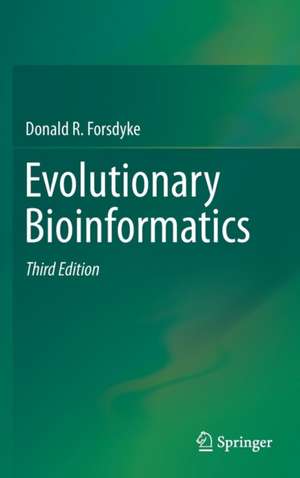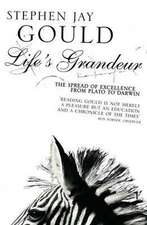Evolutionary Bioinformatics
Autor Donald R. Forsdykeen Limba Engleză Hardback – 10 mai 2016
| Toate formatele și edițiile | Preț | Express |
|---|---|---|
| Paperback (2) | 954.45 lei 6-8 săpt. | |
| Springer International Publishing – 27 mai 2018 | 954.45 lei 6-8 săpt. | |
| Springer – 24 noi 2014 | 1340.08 lei 6-8 săpt. | |
| Hardback (1) | 1396.43 lei 6-8 săpt. | |
| Springer International Publishing – 10 mai 2016 | 1396.43 lei 6-8 săpt. |
Preț: 1396.43 lei
Preț vechi: 1702.96 lei
-18% Nou
Puncte Express: 2095
Preț estimativ în valută:
267.22€ • 277.18$ • 222.82£
267.22€ • 277.18$ • 222.82£
Carte tipărită la comandă
Livrare economică 27 martie-10 aprilie
Preluare comenzi: 021 569.72.76
Specificații
ISBN-13: 9783319287539
ISBN-10: 3319287532
Pagini: 658
Ilustrații: XXXIV, 471 p. 116 illus., 24 illus. in color.
Dimensiuni: 155 x 235 x 29 mm
Greutate: 0.89 kg
Ediția:3rd ed. 2016
Editura: Springer International Publishing
Colecția Springer
Locul publicării:Cham, Switzerland
ISBN-10: 3319287532
Pagini: 658
Ilustrații: XXXIV, 471 p. 116 illus., 24 illus. in color.
Dimensiuni: 155 x 235 x 29 mm
Greutate: 0.89 kg
Ediția:3rd ed. 2016
Editura: Springer International Publishing
Colecția Springer
Locul publicării:Cham, Switzerland
Public țintă
GraduateCuprins
Part 1. Information and DNA.- 1. Memory – A Phenomenon of Arrangement.- 2. Chargaff’s First Parity Rule.- 3. Information Levels and Barriers.- Part 2. Parity and Non-Parity.- 4. Chargaff’s Second Parity Rule.- 5. Stems and Loops.- 6. Chargaff’s Cluster Rule.- Part 3. Variation and Speciation.- 7. Mutation.- 8. Species Survival and Arrival.- 9. The Weak Point.- 10. Chargaff’s GC Rule.- 11. Homostability.- Part 4. Conflict within Genomes.- 12. Conflict Resolution.- 13. Exons and Introns.- 14. Complexity.- Part 5. Conflict between Genomes.- 15. Self/Not-Self?.- 16. The Crowded Cytosol.- Part 6. Sex and Error-Correction.- 17. Rebooting the Genome.- 18. The Fifth Letter.- Part 7. Information and Mind.- 19. Memory – What is Arranged and Where?.- 20.Certainty Now Uncertain.
Notă biografică
Donald Forsdyke graduated from St. Mary's Hospital, London University, UK in 1961. After house appointments at St.Mary's (Medical Unit and Department of Psychiatry) and the Addenbrooke's Hospital, Cambridge (Surgery), he began research in Molecular Biology and Cellular Immunology at the Department of Biochemistry, Cambridge (Ph.D. 1967). He was appointed to what was then the Department of Biochemistry at Queen's University in 1968. In 2013 he became President of the John Austin Society for the History of Medicine and Science.
Textul de pe ultima copertă
Now in its third edition and supplemented with more online material, this book aims to make the "new" information-based (rather than gene-based) bioinformatics intelligible both to the "bio" people and the "info" people. Books on bioinformatics have traditionally served gene-hunters, and biologists who wish to construct family trees showing tidy lines of descent. While dealing extensively with the exciting topics of gene discovery and database-searching, such books have hardly considered genomes as information channels through which multiple forms and levels of information have passed through the generations. This “new bioinformatics” contrasts with the "old" gene-based bioinformatics that so preoccupies previous texts. Forms of information that we are familiar with (mental, textual) are related to forms with which we are less familiar (hereditary). The book extends a line of evolutionary thought that leads from the nineteenth century (Darwin, Butler, Romanes, Bateson),through the twentieth (Goldschmidt, White), and into the twenty first (the final works of the late Stephen Jay Gould). Long an area of controversy, diverging views may now be reconciled.
Caracteristici
This title is unique in emphasising non-genic aspects of bioinformatics, and linking modern evolutionary biology to a history that extends back to the nineteenth century Identifies the types of information that genomes transmit and shows how competition between different types is resolved in the genomes of different organisms Illustrates how forms of information that we are familiar with are related to forms we are less familiar with Includes supplementary material: sn.pub/extras















